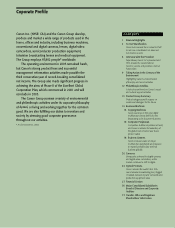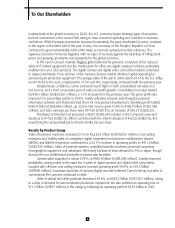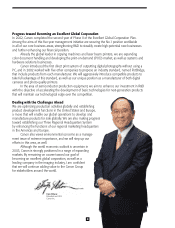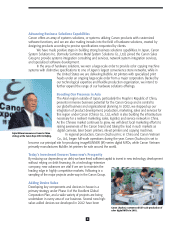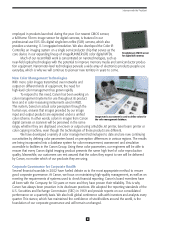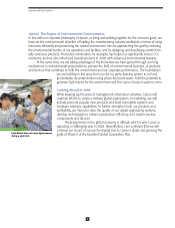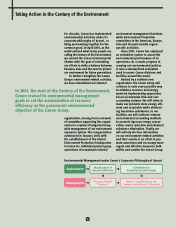Canon 2002 Annual Report Download - page 12
Download and view the complete annual report
Please find page 12 of the 2002 Canon annual report below. You can navigate through the pages in the report by either clicking on the pages listed below, or by using the keyword search tool below to find specific information within the annual report.
10
Leading Eco-Design for
Bubble Jet Printers
LCA analysis played a vital role in the
development of Canon’s new i550 and
i850 Bubble Jet printers (to be released
globally in the spring of 2003). Innovations
such as a CPU clock stop/start function in
the logic circuitry helped significantly
reduce power consumption when the
printers are inactive, resulting in power
savings of almost 70%, compared with
their predecessors.
To maximize resource efficiency, we
developed a system to process paper cas-
settes collected from used Canon copying
machines into the raw material for a new
plastic meeting the quality and durability
standards of Underwriters Laboratories
Inc. We also almost completely removed
hazardous lead and chrome from parts.
We plan to utilize these environmentally
friendly technologies throughout the
Bubble Jet printer lineup, and continue
efforts to further improve the eco-design
features of our Bubble Jet printers.
Radically Reducing Warm-Up Time
To lower the power consumed by its color
laser beam printers, Canon has developed
the world’s first color induction-heating
(IH) fixing technology. The IH sleeve con-
sists of a thin metallic film with
a rubber
Canon is implementing thorough Life Cycle Assessment
(LCA), promoting green procurement, developing small-
er
and lighter products, enhancing recyclability and
reducing hazardous substances. To promote more envi-
ronmentally
conscious products, we are also actively
employing 3D-CAD utilities, which allow our engineers
to examine new designs on-screen, to make products
easier to disassemble for resource recycling and reuse.
covering and a coil, which generates heat
via high-frequency electric current. Heat
from the sleeve is rapidly relayed to the
system, reducing warm-up time by up to
90% and radically lowering power require-
ments during operation and in standby
mode. Compact and located close to the
toner on the paper, the IH sleeve also
helps reduce overall printer size.
Taking a Materials Approach to
Cameras
To reduce hazardous materials, Canon has
adopted lead-free glass in most of its camera
and video camcorder lenses. In addition,
many of the external parts in the ELPH
(IXUS) Advanced Photo System camera
and PowerShot DIGITAL ELPH (DIGITAL
IXUS) digital camera series are made with
aluminum and stainless steel, which are
easy to recycle and reuse. Reducing the
size of these cameras has cut material
requirements, and we have developed
packing materials made from deadwood,
which has no other viable applications.
Bubble Jet printers realizing both energy
savings and resource efficiency
Canon’s originally developed color IH fixing
technology radically reduces warm-up time.
Targeting Environmentally Conscious Products
Canon adopts lead-free lenses in its products.


